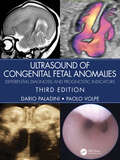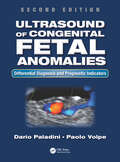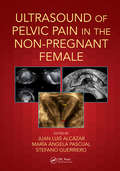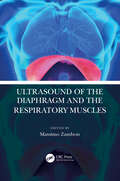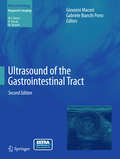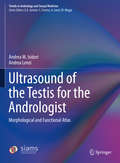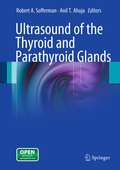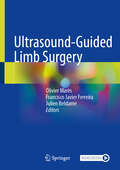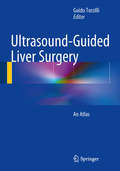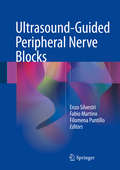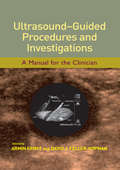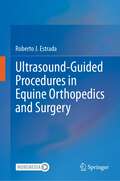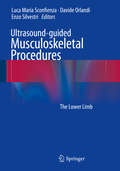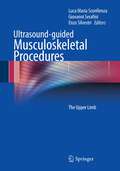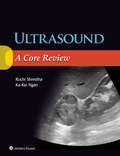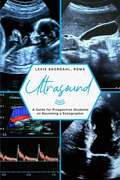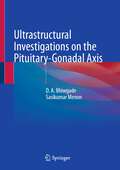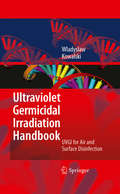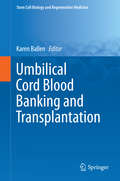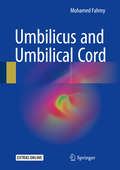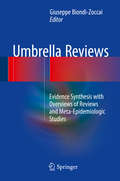- Table View
- List View
Ultrasound of Congenital Fetal Anomalies: Differential Diagnosis and Prognostic Indicators
by Dario Paladini Paolo VolpeAn acclaimed overview of ultrasound for the prenatal diagnosis of congenital anomalies returns in a new enlarged edition. In particular, the coverage of both Central Nervous System congenital and acquired anomalies as well as Congenital Heart Disease has been expanded enormously, to make this an impressive comprehensive resource for Fetal Neurology and Fetal Cardiology. Together with additional new chapters on guidelines and protocols, equipment, and disorders of sexual differentiation, and new insight into fetal surgery procedures, this third edition almost becomes three books in one.
Ultrasound of Congenital Fetal Anomalies: Differential Diagnosis and Prognostic Indicators, Second Edition
by Dario Paladini Paolo VolpeThe most frequently asked questions that confront the fetal medicine trainee/expert on a daily basis are “Is the finding real or merely an artifact?” and “Is the diagnosis correct?”. However, to be able to find the description of an abnormal ultrasound finding in a textbook, one generally has to search by the definite diagnosis, which has not been done as yet. This uneasy feeling was the first factor that directed the layout of Ultrasound of Congenital Fetal Anomalies: Differential Diagnosis and Prognostic Indicators, Second Edition. Copiously illustrated, the book displays fetal anomalies by scanning view and descriptions of all major ultrasound planes, detailing what can be considered a normal view and what cannot. See What’s New in the Second Edition: Early detection of fetal anomalies (1214 weeks) Ultrasound in fetal infections and in twins The nuchal translucency issue, the newest intracranial translucency as well as the range of congenital anomalies detectable at this gestational age Expanded coverage of heart anomalies, including arrhythmias and early fetal echocardiography The author’s mission continues to be to provide guidance on how to quickly recognize and diagnose congenital fetal anomalies, beginning at the beginning with ultrasound sigh all the way through to final diagnosis.
Ultrasound of Mouse Fetal Development and Human Correlates (Reproductive Medicine and Assisted Reproductive Techniques Series)
by Mary C. Peavey Sarah K. Dotters-KatzFetal development in the mouse is routinely and increasingly utilized for advancing translational research and medical innovation for human obstetrical care. This is the first and only manual to provide necessary content on how this should be handled for accurate and effective data collection. Detailed descriptions and examples demonstrate how researchers and clinicians can use murine fetal and obstetrical data to improve future human applications in diseases such as infertility, recurrent pregnancy loss, intrauterine fetal growth restriction, placental insufficiency, and intrauterine fetal demise, as well as organ-specific developmental disease.
Ultrasound of Pelvic Pain in the Non-Pregnant Patient
by Stefano Guerriero Juan Luis Alcázar María Ángela PascualThere are many possible causes of pelvic pain in a non-pregnant female patient, and it has been estimated to be responsible for nearly 40% of all visits by female patients to a family doctor and 10% of all referrals to specialist gynecologists. However, the topic of how to investigate and diagnose has been surprisingly neglected in print. This important and much-needed text from an internationally respected expert shows how important ultrasound can be as a tool for physicians caring for women's health.
Ultrasound of the Diaphragm and the Respiratory Muscles
by Massimo ZambonUltrasound is the most reliable, easily available, fast, non-invasive technique to study diaphragm function, and is an irreplaceable tool to diagnose, monitor, and follow -up critical respiratory patients. This essential guide analyses every aspect of ultrasound of the diaphragm and respiratory muscles, a reliable assessment whose function is vital to delivering the most suitable treatment. Ultrasound of the Diaphragm and the Respiratory Muscles also provides insight to diagnosing diaphragmatic dysfunction or paralysis following surgery or neuromuscular diseases, to follow the muscular activity and the time-course of atrophy during mechanical ventilation, and to monitor the weaning phase. It is ideal for professionals and trainees practiscing ultrasound in a clinical setting. Key Features Sets the standard for training and competency of this emerging, yet scientifically approved non-invasive technique of ultrasound with all the essential information on how to perform ultrasound and interpret the images obtained. Features clear and didactic images demonstrating echo findings in various situations along with videos of diaphragmatic ultrasound offering a unique "window" on mechanically ventilated patients, allowing to take important clinical decisions on ventilatory modes and assistance by pulmonologists, critical care specialists, thoracic surgeons, emergency medicine specialists, as well as trainees. Includes a chapter on paediatric ultrasound along with ultrasound of other respiratory muscles (i.e., intercostal and abdominal) which is emerging as a useful complementary tool.
Ultrasound of the Gastrointestinal Tract
by Giovanni Maconi Gabriele Bianchi PorroThis is the second, updated and extended edition of a well-received book that offers a comprehensive overview of ultrasonographic imaging of acute and chronic gastrointestinal diseases, including acute abdomen, appendicitis, diverticulitis, inflammatory bowel diseases, neoplasms and masses, infections, malabsorption syndromes, and rare conditions. The value of ultrasound in each disorder is clearly explained and illustrated, and limitations identified. Information is also provided on recent technical developments and ultrasound applications that are likely to become of increasing importance, such as functional and 3D ultrasound, contrast agents and intraoperative ultrasound, elastography, and transperineal ultrasound. The authors are all distinguished experts in the topics they address. Ultrasound of the Gastrointestinal Tract will be a helpful guide in daily practice not only for radiologists but also for gastroenterologists, abdominal surgeons, pediatricians, and oncologists.
Ultrasound of the Testis for the Andrologist: Morphological And Functional Atlas (Trends In Andrology And Sexual Medicine Ser.)
by Andrea Lenzi Andrea M. IsidoriThis book presents a comprehensive study of scrotal ultrasound, helping readers cope with the growing number of pathology pictures revealed by accurate ultrasound examinations, and highlighting the novel applications of contrast-enhanced ultrasonography and elastography.This unique reference guide to scrotal ultrasonography draws on the accumulated expertise of the Experimental Medicine Department at “Sapienza” University, where the andrological ultrasonography unit has performed over 10,000 testicular ultrasound examinations for various conditions and explored experimental new imaging techniques. This core experience has been enriched by insightful contributions from several international experts to form one of the most comprehensive collections of ultrasound images, many in full color, of scrotal pathology in the world.The book’s emphasis on functional interpretation of the images, supplemented by clinical data, make it a unique tool for clinical management. This approach is intended to increasingly familiarize clinicians with the potentials of ultrasonography, from the basics to the most advanced approaches, so as to encourage them to incorporate this examination as a central component of the diagnostic pathway
Ultrasound of the Thyroid and Parathyroid Glands
by Robert A. Sofferman Anil T. AhujaThis highly illustrated book, complete with comprehensive clinical references and annotated images, will serve as a leading text to educate head and neck surgeons, endocrinologists, and radiologists on the basics and nuances of thyroid and parathyroid ultrasound. It emphasizes the use of ultrasound as an office-based modality by clinicians and radiologists who actively care for this special set of patients. This text uniquely combines the collaboration between a clinician/surgeon and radiologist who share their extensive experience in head and neck ultrasound.
Ultrasound-Assisted Liposuction: Current Concepts and Techniques
by Onelio Garcia Jr.Liposuction is currently the number one aesthetic surgical procedure performed by plastic surgeons in the United States and Americans spend more money on liposuction than on any other aesthetic surgical procedure. Almost 500,000 cases are currently performed yearly by board certified plastic surgeons and it is estimated that at least 20% of the cases are ultrasound assisted. Current ultrasonic liposuction devices are significantly different than the previous generations and require a certain level of technical expertise in order to achieve good outcomes with the technique. Although there are chapters devoted to the technique in general body contouring textbooks, there are no current textbooks that fully cover this important technique.The text is divided into three distinct sections for ease of use. Section I: Fundamentals will cover basic techniques and safe use of the devices for plastic surgeons looking to add ultrasound-assisted liposuction to their practice. Section II: Clinical Applications explores use of the devices for commonly performed surgeries, including facial, trunk, extremity (arm and leg), and buttock contouring as well as gynecomastia. Section III: Special Applications takes a focused look at the VASER device and its use in more complicated situations, with chapters handling silicone injection complications and contouring in a massive weight loss patient. Featuring contributions from leaders in the field, alongside full color photos and a special introductory video, Ultrasound-Assisted Liposuction serves as a reference for surgeons currently using ultrasonic techniques in liposuction and those looking to get started.
Ultrasound-Guided Limb Surgery
by Olivier Marès Francisco Javier Ferreira Julien BeldameThis book fills an existing gap by offering a comprehensive yet practical overview of ultrasound-guided surgery for the lower and upper limbs. It explains the advantages of this new approach, such as its potential to enhance minimally invasive and/or office-based surgery. Written by a panel of renowned experts in the field, it covers a broad range of pathologies. A wealth of illustrative figures and several videos accompany the explanation of each surgical technique, including tips and tricks, complications, and clinical results. The final part is devoted to the sustainable aspects of ultrasound-guided surgery compared to conventional surgery, such as a lower carbon footprint and reduced waste. This book is an invaluable tool for all orthopedic surgeons wishing to gain insights into this fast-evolving and expanding field.
Ultrasound-Guided Liver Surgery
by Guido TorzilliUltrasound guidance of liver surgery is a very sophisticated approach that permits the performance of otherwise unfeasible operations, discloses the true extent of tumors, increases the indications for hepatectomy, and renders surgery safer. Despite this, it has remained relatively neglected in the literature over the past two decades, during which time much progress has been achieved. This is the first atlas on the subject, and it is comprehensive in scope. The state of the art in the use of ultrasound for resection guidance is carefully documented, and new techniques for exploration of the biliary tract and facilitation of transplant surgery are presented. Further important topics include the role of ultrasound in laparoscopic approaches, the use of contrast agents for diagnosis and staging, and developments in the planning of surgical strategy. The editor is a leading authority whose group has been responsible for a variety of advances in the field. He has brought together other experts whose aim throughout is to provide clear information and guidance on the optimal use of ultrasound when performing liver surgery. This atlas is intended especially for hepatobiliary surgeons but will also be of considerable value for general surgeons.
Ultrasound-Guided Peripheral Nerve Blocks
by Enzo Silvestri Fabio Martino Filomena PuntilloThis book offers a comprehensive but straightforward, practical handbook on ultrasound (US)-guided nerve blocks. It presents the normal US anatomy of peripheral nerves, clinical aspects of nerve entrapment and different procedures / techniques for each block. Axial or peripheral chronic radicular pain can be particularly severe and debilitating for the patient. The aim of treatment is to provide medium-/ long-term pain relief, and consequently to restore function. The therapeutic nerve block, performed with a perineural injection of anaesthetic, steroid or painkiller, is generally used once conservative treatments have proven unsuccessful and is aimed to avoid surgical options. Ultrasound guidance, offering the direct and real-time visualization of the needle and adjacent relevant anatomic structures, significantly increases the accuracy and safety of nerve blocks reducing the risk of intraneural or intravascular injection and the potential damage to the surrounding structures, but also enhances the efficacy of the block itself, reducing its onset and drug doses. This practical volume addresses the needs of physicians dealing with pain management, e.g. anaesthesiologists, radiologists, orthopaedists and physiatrists, with various levels of experience, ranging from physicians in training to those who already perform peripheral nerve blocks with traditional techniques and who want to familiarize with US guided procedures.
Ultrasound-Guided Procedures and Investigations: A Manual for the Clinician
by Armin Ernst David J. Feller-KopmanRecognizing the increasing importance of ultrasonography in the evaluation and management of patients across a range of medical disciplines, this guide provides illustrative instruction on the performance and interpretation of ultrasound examinations in emergency, critical care, hospital, and outpatient settings.
Ultrasound-Guided Procedures in Equine Orthopedics and Surgery
by Roberto J. EstradaThis book serves as a practical guide for equine veterinarians in orthopedics and surgery. It reviews and summarizes the current scientific evidence of the most commonly performed ultrasound-guided procedures for ultrasound-assisted surgery and injections.For the first time, different techniques are compiled and richly illustrated with pictures and videos to guide the practitioner step-by-step. An initial discussion about the general principles of ultrasound-guided procedures sets the bases for clinicians to understand the general technique and apply it to each approach. Additional chapters describe the most common ultrasound-guided injections in different anatomical structures as well as the surgical approaches that are aided or guided with ultrasound.All over the world ultrasound-guided procedures are performed daily in many different fields of equine practice. The main objective of using these approaches is to increase accuracy and minimize tissue trauma when performing diagnostic and therapeutic procedures. Equine orthopedics and surgery are among the major applications of these techniques.Learn about ultrasound-assisted techniques and be part of this trend! Maximize your capacity as a veterinarian, directly affecting the health of your patients. You can access the supplementary videos directly on your smartphone or tablet; simply download the Springer Nature More Media App for free and scan the links with the play button.
Ultrasound-Guided Regional Anesthesia
by Fernando L. Arbona Babak Khabiri John A. Norton Charles Hamilton Kelly WarnimentRegional anesthesia is a fast-growing field, fuelled by the application of ultrasound technology over the last decade. This book is a technique-oriented guide, which introduces the use of ultrasound technology with practical instruction in the placement of peripheral nerve blocks and continuous perineural catheters. Each procedure is summarized for quick, easy reference, and supplemented by ultrasound images, color photos, and detailed illustrations. Helpful hints and instructions are provided to further optimize block success. Chapters are organized into four sections, focusing on introductory concepts, upper extremity peripheral nerve blocks, lower extremity peripheral nerve blocks and continuous perineural catheters. Written by instructors from a major academic medical center who work in a fast-paced ambulatory setting, this is a key text for residents, fellows and staff physicians who wish to incorporate the use of ultrasound into the scope of their anesthetic practice.
Ultrasound-Guided Regional Anesthesia in Children
by Mannion, Stephen and Iohom, Gabriella and Dadure, Christophe and Reisbig, Mark D. and Ganesh, Arjunan Stephen Mannion Gabriella Iohom Christophe Dadure Mark D. Reisbig Arjunan GaneshUltrasound has revolutionized the practice of regional anesthesia, yet there remains a paucity of good resources on ultrasound-guided regional anesthesia in children. This book offers a much-needed practical guide to all the major ultrasound-guided blocks in pediatric patients, including neuraxial, truncal, upper and lower limb blocks. The core principles of good clinical practice in regional anesthesia are described and discussed, including the pharmacology of local anesthetics in children, the performance of regional anesthesia, the management of complications, and the clinical anatomy of each block. Every block chapter provides both a 'how to' section and also a comprehensive literature review, with an up-to-date and relevant bibliography for reference and further reading. Chapters are illustrated with unique anatomical images and detailed descriptions. Both trainee and experienced anesthesiologists will find this an essential resource for the safe and effective performance of modern regional anesthesia in children.
Ultrasound-guided Musculoskeletal Procedures
by Enzo Silvestri Luca Maria Sconfienza Davide OrlandiThis handbook is a practical, easy-to-use reference that offers step-by-step instruction on ultrasound-guided interventional procedures for treatment of musculoskeletal pain of the lower limb. Each chapter is clearly structured and starts by offering a brief but comprehensive description of the disease to be treated that covers aspects such as epidemiology, etiology, clinical presentation and ultrasound diagnosis. The equipment and drugs needed for each interventional procedure are listed and the procedure itself is then described in detail. Explanatory images and easy-to-read schemes ensure that the reader will be able to follow procedures without difficulty, and helpful practical tips and tricks are highlighted for use in daily clinical routine. This is the sister volume to the previously published Ultrasound-Guided Musculoskeletal Procedures: The Upper Limb from the same editors.
Ultrasound-guided Musculoskeletal Procedures
by Enzo Silvestri Luca Maria Sconfienza Giovanni SerafiniAs it is quick, inexpensive, and non-invasive, ultrasound is the modality of choice for guidance of interventional procedures in the soft tissues. Furthermore, the rising mean age of the general population is being accompanied by increasing demand among patients for minimally invasive procedures to treat painful chronic and degenerative syndromes of the musculoskeletal system. This handbook is a clear, practical guide to ultrasound-guided minimally invasive treatments of musculoskeletal pain in the upper limb. Each chapter is clearly structured, with brief but comprehensive descriptions of the disease to be treated and of the materials and drugs needed. High-quality images and easy-to-follow schemes explain the best approach in each situation, and practical tips and tricks of value in daily clinical routine are provided.
Ultrasound: A Core Review
by Ruchi Shrestha Ka-Kei NganUniquely designed for the Core Exam, Ultrasound: A Core Review covers all key aspects of ultrasound, mimicking the image-rich, multiple-choice format of the actual test. Ideal for residents getting ready for the Core Examination, as well as practitioners taking recertification exams, this one-of-a-kind review follows the structure and content of what you’ll encounter on the test, effectively preparing you for Core Exam success!
Ultrasound: A Guide for Prospective Students on Becoming a Sonographer
by Lexie SkordahlWant to become a sonographer? This is the book for you. This is a step-by-step guide on how to get into ultrasound. It contains information on... How to get your pre-requisites How to apply to a sonography program How to acquire all your volunteer and job shadow hours prior to application How to get your first job This book also covers... What ultrasound really is - explains all the exams and procedures What an ultrasound program is like and what to expect What to expect during clinicals What credentials you need and how to get them and more!
Ultrastructural Investigations on the Pituitary-Gonadal Axis
by D. A. Bhiwgade Sasikumar MenonThis book provides the ultrastructural study of the pituitary–gonadal axis through the electron microscope. It is a compilation of extensive work carried out by Dr. D.A. Bhiwgade and his researchers over the last four decades. It explains the ultrastructural characteristics of pituitary cells in different morphological states and provides a comprehensive approach to identifying the structural and functional distinctions between various pituitary cell types. The book includes ultrastructural evaluations of the testis and epididymis after different experimental interventions to study the physiological correlations of the organs with spermatogenesis and the consequent structural deformities in sperm. An extensive section of different types of placentae is added for understanding the varied interactions of fetal and maternal tissues in the placental barrier. Placental types seen in bats, shrews, rodents, and monkeys are explained at the ultrastructural level to distinguish the tissue interrelationships within different placental layers. Detailed sketches have been provided to illustrate the correlations between the maternal and fetal tissues in different placental types for better understanding. This book is a ready reckoner and offers guidance to researchers and clinicians in understanding the cellular architecture and intracellular changes associated with various physiological states and clinical conditions of the pituitary, testis, epididymis, and placenta. This book offers assistance to all those using electron microscopy to evaluate cellular and tissue systems.
Ultraviolet Germicidal Irradiation Handbook
by Wladyslaw KowalskiThis book is a comprehensive source for technical information regarding ultraviolet germicidal irradiation (UVGI) and its application to air and surface disinfection for the control of pathogens and allergens. The primary focus is on airborne microbes and surface contamination applications for hospitals, commercial facilities, and residential homes. All aspects of UVGI systems, including design methods, sizing methods, modeling, safety, installation, testing, guidelines, and disinfection theory are addressed in detail. An extensive database of over six hundred UV rate constant studies is included as well as tabular performance data for UV lamps and products. Providing this information in one single source simplifies the design and installation of UVGI systems, helps guarantee effective performance of new systems, and facilitates their use on a wide scale for the purpose of improving human health. This book is organized to provide systematic coverage of all related issues and will serve equally well as both a textbook and a handbook for general reference.
Umbilical Cord Blood Banking and Transplantation
by Karen BallenThis comprehensive volume discusses the current scope of umbilical cord blood transplantation (UCBT), including recent controversies and future developments for improving clinical outcomes. Its twenty chapters introduce new applications in regenerative medicine and discuss the latest scientific, regulatory, clinical and investigational aspects of cord blood banking. Physicians from around the world provide a global collaboration which explores strategies for umbilical cord blood expansion, homing, unit selection, and combining of graft sources to improve patient outcomes. Umbilical Cord Blood Banking and Transplantation also reviews advances in pediatric UCBT for hematologic and non-hematologic disorders as well as immune recovery, which is critical to preventing infection. Finally, it compares UCBT with other graft sources in an attempt to understand the optimal graft source for the individual patient. UCBT is an important option for many patients who need a transplant but do not have a family donor or a matched unrelated donor. The collective and timely knowledge presented here is essential reading for any regenerative medicine investigator, cord blood banker, transplant laboratory scientist or clinical physician interested in improving and expanding the applications of umbilical cord blood.
Umbilicus and Umbilical Cord
by Mohamed FahmyThis book discusses the importance of umbilical cord and umbilicus as a unique structure, in health and in different diseases. All congenital anomalies of the umbilical cord as well as acquired diseases are explained and discussed with illustrations and animations.Starting from complications during and after birth, the book then covers childhood and adolescent umbilical abnormalities. Conditions such as umbilical stump diseases and anomalies, gastroschisis, omphalocele and urachal anomalies are discussed and explained, highlighting recent advances in their management. Among the contents are also chapters offering a cultural and historical perspective to the topic.Written by a top pediatric surgeon this book brings decades of practical knowledge to readers, highlighting the importance of the umbilicus in development and childhood health.
Umbrella Reviews
by Giuseppe Biondi-ZoccaiThis book is an ideal guide to umbrella reviews, overviews of reviews, and meta-epidemiologic studies for evidence synthesis. Research is conducted at different levels: primary research consists of original studies while secondary research comprises qualitative reviews, systematic reviews, and meta-analyses. Recently, a novel further level of research has been introduced, based on the analysis and pooling of reviews and meta-analysis. This book is the first to focus solely on this new type of research design, which permits a comprehensive and powerful synthesis of scientific evidence in medicine as well as in many other fields in order to inform decision-making. All aspects are covered, including review design and registration, the searching, abstracting, appraisal, and synthesis of evidence, the appraisal of moderators and confounders, and state of the art reporting. Case studies in a range of medical specialties are then presented. The hands-on approach of the book, written by a multinational team of experts, will enable the reader to interpret and independently conduct umbrella reviews.
